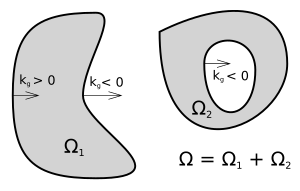Gauss-Bonnet theorem facts for kids
The Gauss-Bonnet theorem is a special idea in mathematics that connects two different ways of looking at shapes: their geometry and their topology. Imagine a shape, like a ball or a donut. Geometry is about its curves and measurements, while topology is about its basic form, like how many holes it has. This theorem shows a surprising link between these two ideas. It's named after two brilliant mathematicians, Carl Friedrich Gauss and Pierre Ossian Bonnet, who discovered it separately.
Contents
What is the Gauss-Bonnet Theorem?
The Gauss-Bonnet theorem is a powerful rule in geometry that links the curvature of a surface to its topology. Think of it as a way to understand how bumpy or flat a surface is (its curvature) and how many holes it has (its topology). This theorem is very important in many areas of science and engineering.
Who Discovered It?
This amazing theorem is named after two famous mathematicians:
- Carl Friedrich Gauss (1777-1855): He was a German mathematician and scientist. Many people call him the "Prince of Mathematicians." He made huge discoveries in many fields, including number theory, algebra, statistics, and geometry.
- Pierre Ossian Bonnet (1812-1872): He was a French mathematician. He worked on geometry and helped develop the ideas that led to this theorem.
Both Gauss and Bonnet found this theorem on their own, which shows how important and natural this connection between geometry and topology is.
Understanding Geometry and Topology
To understand the Gauss-Bonnet theorem, it helps to know what geometry and topology mean.
Geometry: The Shape's Curves
Geometry is the study of shapes, sizes, positions, and properties of space. When we talk about the geometry of a surface, we are looking at how it curves.
- Imagine a flat table. It has no curve.
- Now imagine a ball. It curves everywhere.
- A saddle shape curves one way in one direction and the opposite way in another.
The Gauss-Bonnet theorem uses something called Gaussian curvature. This is a way to measure how much a surface curves at any single point. It tells us if the surface is like a ball (positive curvature), a saddle (negative curvature), or flat like a table (zero curvature).
Topology: The Shape's Holes
Topology is a part of mathematics that studies shapes that can be stretched, twisted, or bent without tearing or gluing. It's about the basic properties that don't change even if you deform the shape.
- A coffee cup and a donut are topologically the same. You can stretch a donut into the shape of a coffee cup with a handle without tearing it. Both have one hole.
- A ball and a cube are topologically the same. You can inflate a cube into a ball. Neither has any holes.
The Gauss-Bonnet theorem uses something called the Euler characteristic (pronounced "Oiler"). This number tells us about the number of "holes" or "handles" a surface has.
- For a sphere (like a ball), the Euler characteristic is 2.
- For a torus (like a donut), the Euler characteristic is 0.
- For a surface with two holes, it would be -2.
How the Theorem Connects Them
The Gauss-Bonnet theorem says that if you add up all the curvature across an entire surface, that total amount will be directly related to the number of holes or handles the surface has (its Euler characteristic).
In simpler words, it means:
- The way a surface curves everywhere (geometry)
- Is connected to its fundamental shape and how many holes it has (topology).
This is amazing because it links a local property (curvature at each point) to a global property (the overall shape and holes). It's like saying if you know how bumpy every tiny bit of a surface is, you can figure out if it's a ball, a donut, or something else entirely!
Why is it Important?
The Gauss-Bonnet theorem is very important in many areas:
- Physics: It helps scientists understand the shape of space and time in theories like general relativity.
- Computer Graphics: It's used in creating realistic 3D models and animations.
- Engineering: It can be applied in designing complex shapes and structures.
- Pure Mathematics: It's a foundational result that connects different branches of mathematics, leading to even more discoveries.
It shows us that even very different ideas in mathematics can be deeply connected, revealing the hidden beauty and order in the world around us.
See also
 In Spanish: Teorema de Gauss-Bonnet para niños
In Spanish: Teorema de Gauss-Bonnet para niños


